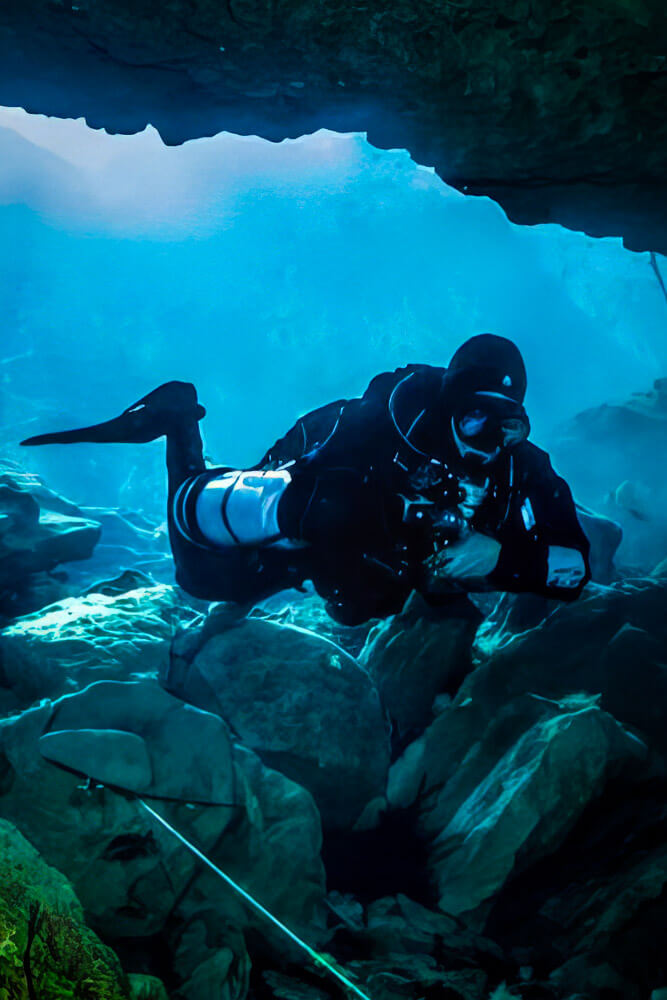Rebreather Cavern


This course is designed to develop the minimum skills and knowledge for diving a TDI approved rebreather in cavern and overhead environments within the limits of light penetration; in addition, outline specific hazards associated with rebreather cave diving. The Rebreather Cavern course is not intended to provide instruction for diving in cave environments. The objective of this course is to train divers in the proper planning, procedures, techniques and hazards of rebreather cavern diving.
Interested?
Who this course is for:
The certified TDI CCR Air Diluent diver or equivalent that has interest in taking their rebreather into the cavern diving zone.
Course prerequisites:
- Minimum age 18
- Minimum certification requirement: TDI CCR Air Diluent Diver, or equivalent
- Provide proof of a minimum of 25 logged dives and 25 hours on the rebreather unit used in training
What you can expect to learn:
The TDI Full Cave Diver Course takes an in-depth look at all of the following and more.
- Policies for rebreather cavern diving
- Psychological considerations
- Equipment considerations
- Bailout cylinder options
- Rebreather configuration options
- Scrubber options
- Buoyancy compensator device (BCD) / harness options
- Reel options
- Proper weighting
- Equipment configurations
- Communication
- Hand signals
- Light signals
- Touch contact signals
- Swimming techniques
- Body posture / trim
- Buoyancy control and rebreather weighting
- Line following techniques
- Propulsion techniques
- Physiology
- Breathing techniques
- Stress management
- Cave environment
- Geology
- Local access requirements
- Land owner relations
- Conservation
- Problem solving
- Equipment failure
- Silting conditions
- Accident analysis
- Review of dive tables and decompression theory
- Cavern diving with Open Circuit (OC) divers
- Bailout configuration requirements
- Out of gas emergencies
- Cavern diving etiquette
Skills you will have to demonstrate:
Some of the required skills you will have to demonstrate include all of the following and more:
- How to properly:
- Deploy a guideline
- Follow a guideline
- Conduct bailout exit including bottle swapping while following a guideline
- Conduct bailout exit including bottle swapping simulating zero visibility and using touch contact while following a guideline
- Use of safety reel in:
- Lost diver procedures
- Lost line drill
- S-drills to be performed on all dives
- Demonstrate adequate pre-dive planning
- Equipment check and equipment matching
- Demonstrate:
- Specialized propulsion techniques in varying types of flow
- Proper buoyancy control, body posture, stress analysis, oxygen partial pressure management, and overall rebreather instruments analysis
- Remove and replace mask while in contact with the guideline
- Demonstrate light / hand signals and touch contact
- Execute conservation and awareness techniques
- Explore Cavern
- Use referencing as back-up navigation
- Demonstrate adequate anti-silting techniques
- Simulate a primary light failure, and use back light to exit the cavern
- Demonstrate rebreather unit specific skills in compliance with current level of rebreather certification as outlined in the TDI course curriculum
What’s in it for you:
Upon successful completion of this course, graduates may engage in rebreather cavern diving activities without direct supervision provided the graduates adhere to the following requirements:
- Daylight zone, i.e. within natural light of the cavern entrance
- Diver carries adequate bailout to safely exit from the furthest point of penetration using a minimum SACrate of 30 litres per minute/1 cubic foot per minute OR the student’s calculated elevated SAC rate to account for a CO2 event, whichever is greater
- 60 linear metres / 200 linear feet from the surface
- 30 metres / 100 feet maximum depth
- No decompression diving
- No restrictions; no areas too small for 2 divers to pass side-by-side
- Safety stops as appropriate or necessary
- Maintain a continuous guideline
- Proper cavern diving equipment is used in conjunction with a TDI approved rebreather
- No removal of life support equipment shall be permitted within the overhead environment
- Visibility must be adequate to identify the exit from inside the cavern
Upon successful completion of this course, graduates are qualified to progress on to the next level of overhead environment training: the TDI Rebreather Intro to Cave Diver course!
Minimum requirements:
- Satisfactorily complete the TDI Cave Diver Course written examination with an 80% passing grade, followed by 100% remediation by the Instructor
- Perform all land drills and cave dive requirements efficiently
- Demonstrate mature, sound judgment concerning dive planning and execution
- Maintain an appropriate level of awareness and respect for the environment
- Log all training dives